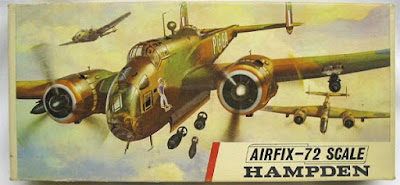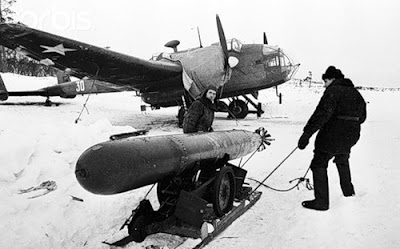The Hampden served in the early stages of Second World War, bearing the brunt of the early bombing war over Europe, taking part in the first night raid on Berlin and the first 1,000-plane raid on Cologne. As the war went on, it became clear that the Hampden was unsuited to combat missions in the modern air war and, after a period of mainly operating at night, it was retired from RAF Bomber Command service in late 1942.
While the Hampden was powered by Bristol Pegasus radial engines, a short-lived variant known as the Handley Page Hereford instead featured in-line Napier Daggers.
In September 1938, No. 49 Squadron received the first Hampdens; by the end of the year, both 49 and 83 Squadrons at RAF Scampton had re-equipped with the type. A total of 226 Hampdens were in service with ten squadrons by the start of the Second World War, with six forming the operational strength of 5 Group of Bomber Command based in Lincolnshire.
By late 1938, the mass manufacturing plans for the Hampden had been formalised. In addition to Handley-Page's own production line, the type was to be built under subcontract by English Electric at their factory in Preston, Lancashire; on 6 August 1938, English Electric was awarded an initial contract to manufacture 75 Hampdens. In addition, Canadian interest in domestic production of the type had resulted in the establishment of the joint Anglo-Canadian Canadian Associated Aircraft company, which promptly received an initial order from the RAF for 80 Hampdens to be completed in Canada; this facility would effectively act as a shadow factory during wartime.
On 1 September 1938, in response to interest expressed by the Royal Swedish Air Force (RSAF) in the Hampden, including in a potential licence production arrangement for 70 aircraft to be built in Sweden, a single production Hampton was supplied to Sweden. Designated P.5 by the RSAF, it was operated by the service through to November 1945, after which it was sold to Svenska Aeroplan AB (SAAB) to serve as a flying testbed before being retired in late 1947.
On 22 February 1940, the first Preston-built Hampden, P2062, conducted its maiden flight. English Electric would go onto manufacture a total of 770 Hampdens, more than any other company, prior to delivering its final aircraft on 15 March 1942.
In July 1940, Handley-Page terminated its own production line for the Hampden upon the completions of its 500th aircraft. On 9 August 1940, the first Canadian-built Hampden, P5298, made its first flight; by October 1940, Canadian production had risen to 15 aircraft per month. A total of 160 Hampdens were completed by Canadian Associated Aircraft, many of which were ferried to the United Kingdom for wartime service, the final Canadian-built aircraft was deliver in late 1941
With the outbreak of war in 1939, Hampdens were initially used to perform armed aerial reconnaissance missions, observing German naval activity during daylight. However, despite its speed and manoeuvrability, the Hampden proved to be no match for Luftwaffe fighters; in December 1939, Bomber Command is claimed to have concluded to have discarded the belief that aircraft such as the Hampden could realistically operated by day and instead chose to predominantly deploy them under the cover of darkness during nighttime operations. During 1940, Hampdens of 5 Group conducted 123 nighttime airborne leaflet propaganda missions, losing only a single aircraft in the process.
On 13 April 1940, days after Germany's invasion of Norway, a large number of Hampdens were dispatched on night-time mine-laying (code-named "gardening") flights in the North Sea in areas deemed unapproachable by British shipping. According to Moyes, this activity proved highly effective, experiencing a low casualty rate of less than 1.9 aircraft per sortie. The Hampden also saw a return to its use as a daytime bomber during the Norwegian Campaign, but quickly proved to be under-gunned to fend off German fighters.
On 19 March 1940, Hampdens took part in the first deliberate bombing of German soil in a nighttime raid upon the seaplane hangers and slipways in Hörnum, Sylt.[8] The type continued to operate at night on bombing raids over Germany. Flight Lieutenant Rod Learoyd of 49 Squadron, was awarded the Victoria Cross for the attack that he led on the Dortmund-Ems canal on 12 August 1940. On 25 August 1940, Hampdens from various squadrons participated on the RAF's first bombing raid on Berlin. Sergeant John Hannah was the wireless operator/air gunner of an 83 Squadron Hampden and was awarded the Victoria Cross on 15 September 1940, when he fought the flames of the burning aircraft, allowing the pilot to return it to base.
In April 1942, the Hampden-equipped 144 Squadron and 455 Squadron RAAF were transferred from Bomber Command to Coastal Command to perform the torpedo bomber role. Later that year, detachments from both squadrons were dispatched to Vaenga, Murmansk, Russia, to help safeguard the Arctic convoys in the vicinity.
A total of four squadrons assigned to Coastal Command would be equipped with Hampdens; these squadrons continued to be use the type into late 1943, on 10 December 1943, the last Coastal Command squadron transitioned from the type.
Almost half of the Hampdens built, 714, were lost on operations, taking with them 1,077 crew killed and another 739 missing. German flak accounted for 108, one hit a German barrage balloon, 263 Hampdens crashed because of "a variety of causes" and 214 others were classed as "missing". Luftwaffe pilots claimed 128 Hampdens, shooting down 92 at night.[21] Guy Gibson spent most of the first two years of his wartime service flying Hampdens and his book Enemy Coast Ahead (1946) gives a strong flavour of the trials and tribulations of taking these aircraft into action.
The last Bomber Command sorties by Hampdens were flown on the night of 14/15 September 1942 by 408 Squadron, RCAF against Wilhelmshaven. After being withdrawn from Bomber Command in 1942, it operated with RAF Coastal Command through 1943 as a long-range torpedo bomber, (the Hampden TB Mk I with a Mk XII torpedo in an open bomb bay and a 500-pound (230 kg) bomb under each wing) and as a maritime reconnaissance aircraft.
The Hampden was also used by the Royal Canadian Air Force (RCAF), Royal Australian Air Force (RAAF), Royal New Zealand Air Force (RNZAF), Aviatsiya Voenno-Morskogo Flota (AV-MF: Maritime Military Fleet Aviation) of the Soviet Union and the Swedish Flygvapnet (Air Force).
The Hampden in RCAF service included the 160 examples manufactured in Canada by the Victory Aircraft consortium. Of the total built, 84 were shipped by sea to Great Britain, while the remainder came to Patricia Bay (Victoria Airport) B.C., to set up No. 32 OTU (RAF) used for bombing and gunnery training. Typical exercises at 32 OTU consisted of patrolling up the West Coast of Vancouver Island at night or flying out into the Pacific to a navigational map coordinate, often in adverse and un-forecast inclement weather. Due to attrition from accidents, about 200 "war weary" Hampdens were later flown from the U.K. to Pat Bay as replacements.
In September 1942, the crews of 32 Hampdens from No. 144 Squadron RAF and No. 455 Squadron RAAF flew from Sumburgh in the Shetland Islands to Vaenga (renamed Severomorsk in 1951) in Murmansk Oblast, Russia, a hazardous route often subject to poor weather and spanning more than 2,100 nautical miles (3,900 km), partly over enemy-occupied territory in Norway and Finland.
Nine Hampdens were lost en route. From Vaenga, 144 and 455 Squadrons escorted Arctic Convoy PQ 18. After the convoy arrived, the Wing's personnel returned by sea to the UK and the 23 surviving Hampdens were transferred to the Aviatsiya Voenno-Morskogo Flota. These Hampdens were then flown by the 3rd Squadron of 24 MTAP (″Минно-торпедный авиаполк/Mine-torpedo aviation regiment [Anti-Shipping Wing]) until at least 1943. The Flygvapnet assigned an HP.52 to Reconnaissance Wing F 11 at Nyköping for evaluation, under the designation P5. After the war, the aircraft was sold to SAAB where it was used as an avionics testbed.
General characteristics
Crew: 4 (pilot, navigator/bomb aimer, radio operator/dorsal gunner, ventral gunner)
Length: 16.32 m
Wingspan: 21.09 m
Height: 4.55 m
Wing area: 62.1 m2
Empty weight: 5,789 kg
Max. takeoff weight: 10,206 kg
Powerplant: 2 × Bristol Pegasus XVIII 9-cyl, 1000 hp / 754 kW at 900 m each
Maximum speed: 397 km/h at 4,210 m
Cruise speed: 332 km/h at 4,580 m
Range: 2,768 km max fuel and 910 kg bombs, 332 km/h
Service ceiling: 5,790 m
Rate of climb: 300 m/min
Armament: 1 × fixed forward firing 7.7 mm mg in nose, 3–5 mg one flexibly mounted in the nose, one or two each in dorsal and ventral positions
Bombs: 1,800 kg bombs or 1 × 18 in 457 mm torpedo or mines










Ei kommentteja:
Lähetä kommentti
Kaikenlaiset kommentit ovat tervetulleita.